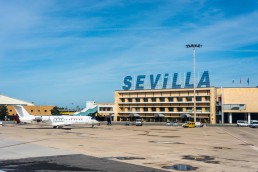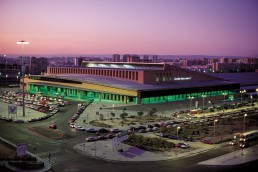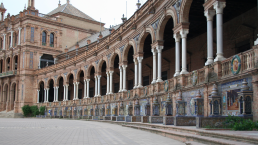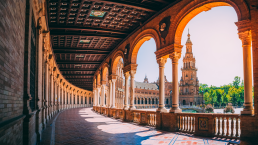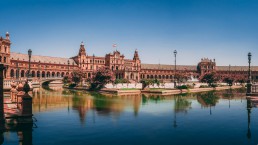Seville is the capital and largest city of the Spanish autonomous community, Andalusia. It is situated on the lower reaches of the River Guadalquivir, in the southwest of the Iberian Peninsula.
Seville is approximately 2,200 years old. The passage of the various civilizations instrumental in its growth has left the city with a distinct personality, and a large and well-preserved historical centre. Seville is a big tourist centre in Spain.
How to get to Seville
Located in the south of Spain, Seville is easily accessible by air, train or road. Malaga and Giblartar are around 2 hours from the city by road. Major cities close to Seville include Madrid and Lisbon, and there are trains and planes to major destinations.
Transport to Seville
If you decide to fly to Seville, you’ll land at the Seville Airport, also called the San Pablo Airport.
From the airport, you can get to the centre of Seville in just 15 minutes if you use your own car, rent a car or take a taxi. And it will take just 35 minutes if you choose the bus.
Taxi
Normal rate at the official taxi stand:
- 20 €: Monday to Friday, 7:00 to 21:00.
- 75 €: Monday to Friday, 21:00 to 7:00. / Saturdays, Sundays and holidays, 24 hours a day.
(Consult rates for Semana Santa, Feria de Abril and requested services by phone).
Special Airport Bus (EA)
- Single ticket: 4 €
- Round – trip ticket: 6 €
- Get off/on at Plaza de Armas
- Timetable
You can reach Santa Justa Station on high-speed lines from Cordoba, Madrid, Zaragoza and Barcelona on the southwest-northeast line of the AVE and from Malaga on the AVANT trains. And thanks to high-speed connections with Europe, today a person could travel, for example, from London to Seville along high-speed rails the whole way.
Santa Justa Station is just a 15-minute walk from the city centre.
Station hours:
- Monday to Friday: 04:30 to 00:30
- Saturdays, Sundays and Holidays: 05:15 to 00:30
Ticket booth hours:
- High-speed and Long distance: 06:00 to 22:00
- Medium distance and Cercanías: Daily: 06:00 to 22:30
- Telephone: (+34) 902 432 343
Seville is well connected by road. A network of highways connects it with all areas: the A-49 links it with Huelva and Portugal. The A-92 links to Malaga and Granada. The A-4 arrives from Cordoba and Madrid. The A-66 connects to Extremadura and the north of Spain.
The SE-30, the Ronda Super Norte and the SE-40 are the bypass roads that facilitate movement around the city and its metropolitan area.
Getting Around
Public transport
The Sevillian bus network is very extensive, and it is perhaps the preferred method by the locals. At most stops, you can find NFC service points where you can check waiting times on your mobile along with all kinds of information about the city. There are also screens providing information on the arrival times of the next bus. The entire fleet is monitored by GPS.
Seville has one metro line. The new, modern light metro crosses the city from East to West (connecting with the metropolitan area).
The Metrocentro is the surface version of the metro, which will help you to reach the very heart of Seville: its monumental area. The route itself is a splendid tourist path.
Taxi
Taxis in Seville are easily recognizable: they are white with a yellow diagonal stripe on the side (the green light indicates that the taxi is available).
- Radio Taxi Giralda (+34) 954 675 555
- Tele Taxi Sevilla (+34) 954 622 222
- Radio Taxi (+34) 954 580 000
What to see – what to do
General Archive of the Indies
World Heritage Site
80 million pages, 8,000 maps and drawings, more than 40,000 files of great historical value. All this preserves in its eight linear kilometres of shelves one of the most significant buildings in Seville: the General Archive of the Indies, declared a World Heritage Site by UNESCO.
The tourist visit to the Archive of the Indies is free of charge.
It can be visited from Tuesday to Saturday from 9:30 to 17:00, and Sundays and public holidays from 10:00 to 14:00.
Giralda of Seville
Blend of Arab architecture and Renaissance style
The Giralda of Seville is a tower of unparalleled size for a building of its era (from the 12th to the 6th century). In fact, for a long time, it was the tallest building in the world (101 metres counting the Giraldillo, the beautiful weathervane that crowns it and one of the symbols of the city). The Giralda is a perfect symbiosis of different architectural styles, different civilizations. It is a tower that begins by being a minaret and ends up being a bell tower. When you climb up to the top, you can see the whole city. At its feet, there is the Patio de los Naranjos and the largest existing Gothic Cathedral.
Cathedral of Seville
The largest Gothic temple in the world
The Cathedral of Seville will leave you perplexed by its proportions. The chronicles say that it was conceived by the Cathedral Chapter members with the words, “Let us build a church so grandiose that those who see it finished will think we are mad”. Everything in the Cathedral is colossal. Admire the main altarpiece, considered by many to be one of the most outstanding works in the history of art. Or examine the mausoleum, which holds the remains of Christopher Columbus.
Plaza de España
A 170-metre diameter hug
The Plaza de España is a spectacle of light and majesty. Framed in the María Luisa Park, this plaza was designed by the great Seville architect Aníbal González as an emblematic space for the 1929 Ibero-American Expo. The result was a plaza-palace unique in the world. Its proportions are lavish. It has a total area of 50,000 square metres, without a doubt one of the most imposing plazas in Spain.
Along the entire perimeter of the plaza, there is a canal of 515 metres in length, which you can travel by boat, a truly romantic experience.
Church of the Divine Salvador
Splendour of the Baroque
The Salvador is a religious temple for Roman Catholic worship under the patronage of Our Lord San Salvador, located in the Plaza del Salvador in Seville and is the largest church in the city, after the Cathedral. Deprived of its parish ranking after the latest restoration work, it currently functions as an exempt church, within the parish jurisdiction of San Isidro. In its patio, you can see glimmers of the Roman and Visigothic eras.
The building was erected on the remains of the Ibn Adabba, the Great Mosque of Muslim Seville (ninth century). This religious temple, as well as its surroundings, had great importance in the daily life of the people, which is why when the Christians conquered Seville, they allowed it to be used as a mosque in the beginning, but in 1340, it was converted into the parish of Salvador. In addition, it was agreed to maintain the ostentatious rank of the second temple of the city; for it was granted a collegiate character. Thus, this building would continue to be used religiously until 1671, when the passage of time left it strongly deteriorated. Its construction as we see it today began in 1674 with the architect Esteban García. Work ended in 1712 under the architect Leonardo de Figueroa. Later it would again be restored with work ending in early 2008, returning the temple to all its splendor.
La Maestranza
The oldest bullring in Spain
The bullring of the Real Maestranza de Caballería in Seville is the oldest bullring in Spain. It is the venue for the bullfights that take place during the April Fair, one of the most famous bullfighting celebrations in the world. It is considered one of the most popular tourist attractions and is among the most visited monuments in the city. As a square it is one of the most complicated in the world due to its layout and characteristics, as well as its public, which is said to be one of the hardest and most difficult among the bullfighting fans.
In 1749, the construction of a round bullring was begun on the Baratillo mountain to replace the rectangular one located in the area. Later, in 1761, the construction was undertaken by ¨ochavas¨ (equivalent to four arches per octave). Francisco Sánchez de Aragón and Pedro y Vicente San Martín are the master builders in this first stage of construction.
The inner part of the square called the Palco del Príncipe (Prince’s Box) was completed in 1765. This box consists of two sections: the gateway to the square, through which the winners go out, and the box itself, for the exclusive use of the Royal Family. Its upper part is made up of four arches, which in its upper part is covered with white and blue tiles.
Real Alcázar
An ensemble of palaces
The Alcázar of Seville has always been used as lodging for kings and important personalities. It is made up of different buildings from different eras. The original fortification was built on an old Roman, later used by the Visogoths. Later is became a Paleochristian basilica (San Vicente Mártir), where San Isidro (Saint Isodore) was buried. The Real Alcázar of Seville began to take on its present appearance after the Arabs took over the city in the year 713. One of the palaces that surrounds two courtyards is of the same era as the Alhambra of Granada. To carry out the work, important craftsmen were sent by the Nasrid King Mohamed V. After the reconquest of the city, in 1248, the “Reales Alcázares” were of the successive monarchs. Alfonso X the Wise made the first reforms, creating three large Gothic salons. Pedro I later decided to build the wonderful Mudéjar Palace.
Strolling through the Alcázar Gardens can be one of the most unforgettable experiences of your visit. They are arranged in terraces, with green vegetation, a multitude of orange and palm trees, with fountains and pavilions where you can breathe the freshness and stillness; a place for calm and rest in the hot city. The Jardines del Príncipe (the Prince’s Gardens) are especially notable, with the Fountain of Neptune, and the Jardines del Naranjal (Naranjal’s Gardens), with the fountain of the Lion, and the Pavilion of Carlos V, where King Fernando III died. The rest of the gardens are more modern, and in them, we can find the shield and name of King Alfonso XIII.
Museum of Fine Arts
The second gallery in Spain
Instituted in September of 1835 and official inaugurated in 1841. It is located in the so-called Plaza del Museo, which is presided over by a sculpture dedicated to Bartolomé Esteban Murillo. It is a fundamental museum for getting to know Sevillian Baroque painting, especially the masters, Zurbarán, Murillo and Valdés Leal, as well as 19th century Andalusian painting. The building that currently houses the Museum was originally built as a convent of La Merced, for the Order of La Merced Calzada de la Asunción, founded by San Pedro Nolasco during the reign of Fernando III.
Highlights of the collection include work from the 17th century, including the works of the most representative Spanish painters, such as Murillo, Velásquez, Zurbarán, and Valdés Leal.
Museum of Traditional Arts and Customs
Collections of Andalusian Popular Ceramics in Europe
Traditional Customs of Seville is located in the María Luisa Park, in the Plaza de América. It occupies the Mudejar Pavilion, a building built in 1914 by the architect Aníbal González. on the occasion of the Ibero-American Exhibition in Seville (1929). It includes a space of 5496 m² for permanent exhibitions and services. In the Mudejar style, it is built in exposed brick with ceramic applications full of designs and fantasy.
During the Ibero-American Exhibition it was known as the “Pavilion of Ancient Art”. Reforms were carried out in 1972. Its functions as a museum have been carried out since March 4, 1973, when it opened its doors to the public. The First Floor and the Semi- basement Floor are equipped as a museum. It is also equipped with an Audiovisual Room, a Conference Room. The collection of Andalusian Traditional Ceramics in the museum is one of the most complex in Europe, as the one in the Hamburg Museum.
Parque de los Príncipes
Located in the Remedios neighbourhood, very close to where the Seville Fair is held in April, the Parque de los Príncipes owes its name to the previous King Juan Carlos and Queen Sofia, who were princes when the park was inaugurated.
Inside, there are two playgrounds, an area for sports, an area for dogs and a river full of ducks with a central island accessed by a bridge. There are rosebushes and a collection of citrus trees throughout the park. We can find oranges, jacarandas, tipuanas and Japanese plum trees, among any others.
Maria Luisa Park
Maria Luisa Park is the most famous park in Seville and one of its best sources of fresh air. Formerly the private gardens of the San Telmo Palace, the land was donated in 1893 by the Infanta Maria Luisa Fernanda de Borbón (the Duchess of Montpensier). The land was reformed by the French Engineer Jean-Claude Nicolas Forestier, conservator of the Boulogne forest in Paris, who gave it a romantic touch, inspired by the gardens of the Generalife, the Alhambra and the Alcázares of Seville.
The Plaza of España and the Plaza de América were opened in the park for the Iberoamerican Expo in 1929, being some of the main attractions. Their fountains give that arabesque touch that adds sound to help you peacefully relax among its many tiled and detailed benches, which describe works of literature and other arts


